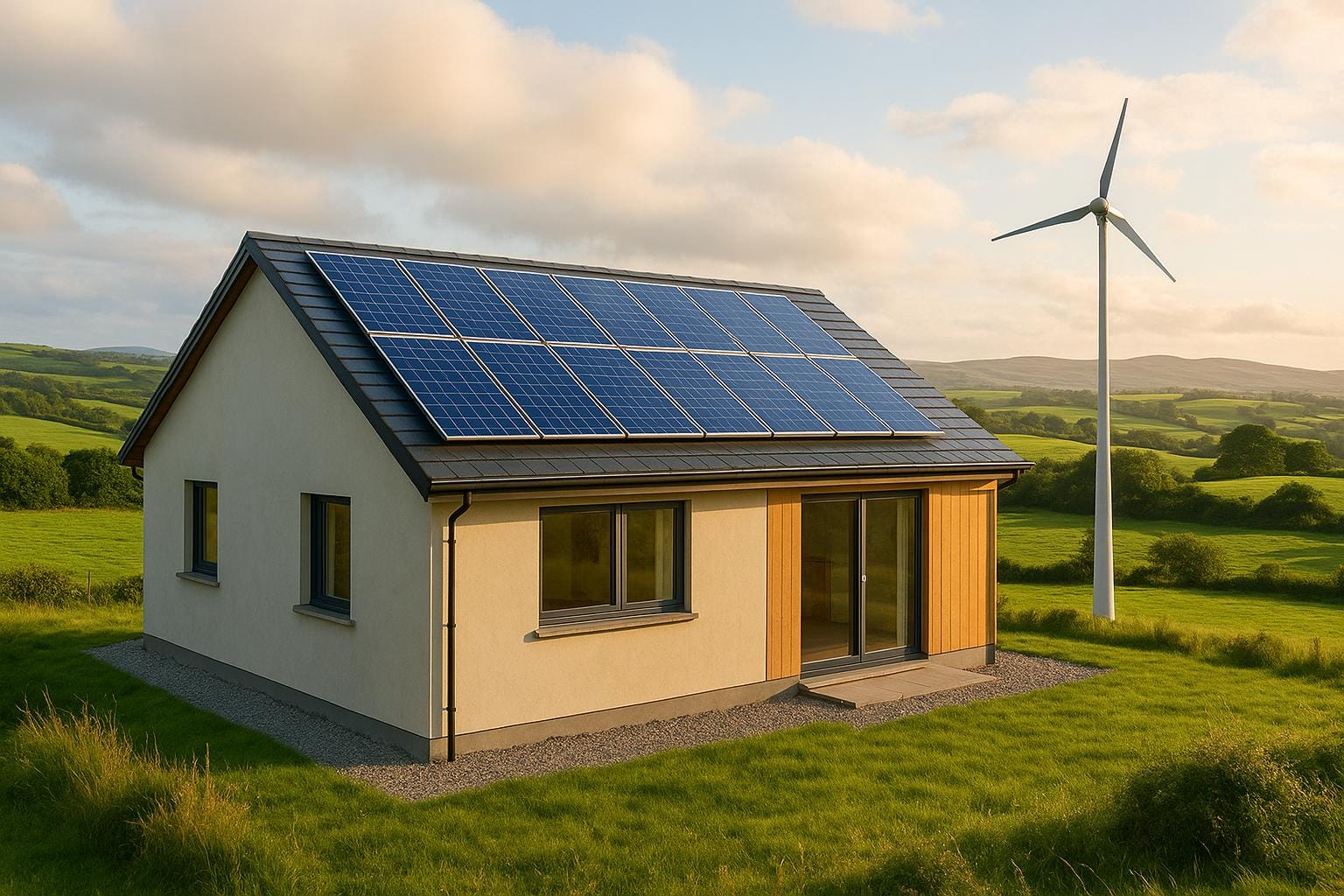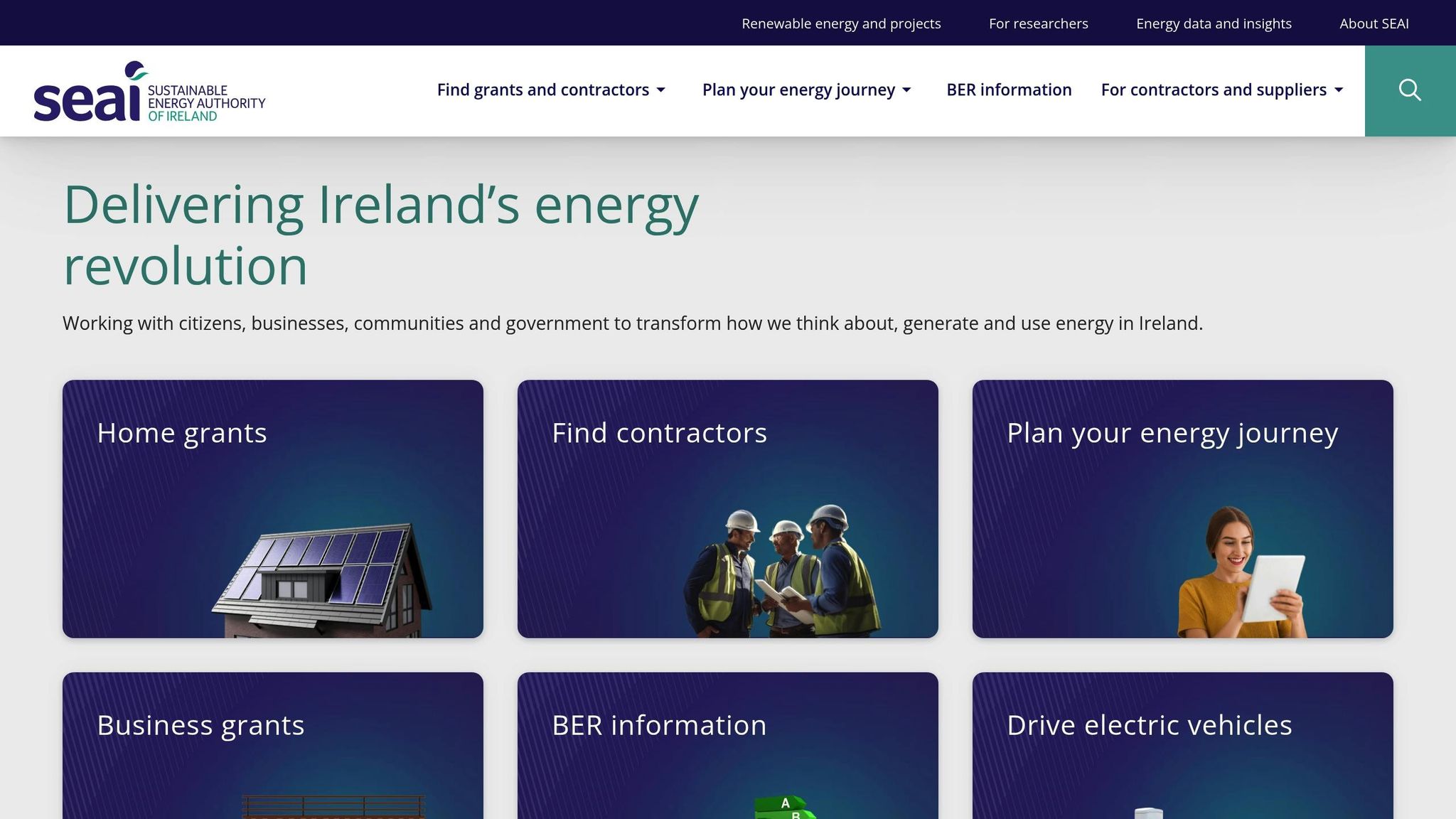Off-Grid Solar Costs in Ireland: Guide 2025
Explore the costs, grants, and benefits of off-grid solar systems in Ireland, helping you make an informed decision for energy independence.

- Costs: Off-grid systems range from $44,000 to $132,000, depending on size and features. Key components include solar panels, batteries, inverters, and control systems.
- Grants: The SEAI offers up to $1,980 (€1,800) in grants, plus zero VAT on installations, cutting costs by up to 41%.
- Payback: Systems pay for themselves in 8–12 years, with annual maintenance costs between $238 and $595.
- Best for: Remote properties, farms, and areas with unreliable grid access.
Quick Comparison: Off-Grid vs. Grid-Connected Solar
| Feature | Off-Grid Solar | Grid-Connected Solar |
|---|---|---|
| Cost | $47,600–$142,800 | $5,700–$10,350 |
| Battery Storage | Required ($14,280–$29,750) | Optional ($4,760–$8,330) |
| Backup Power | Required ($2,380–$7,140) | Not needed |
| Payback Period | 15–25 years | 5–6 years |
| Best Use | Remote or off-grid properties | Urban or suburban areas |
Off-grid solar offers energy independence but comes at a higher upfront cost. If your property is in a remote area or you value self-sufficiency, this guide will help you decide if it's the right choice for you.
Off Grid living for beginners, solar and battery system installation on farm building Ireland
Off-Grid Solar System Costs
Let's dive into the details of what drives the costs of off-grid solar systems in 2025. The total expense depends on factors like system size, the components you choose, and how the installation is handled.
Main Cost Elements
An off-grid solar system is made up of several key components, each playing a role in the overall cost. Here's a breakdown of the major elements and their price ranges (in U.S. dollars):
| Component Type | Cost Range | Notes |
|---|---|---|
| Solar PV & Battery Storage | $13,200 – $27,500 | Core for energy generation and storage |
| Wind Turbine (optional) | $4,400 – $16,500+ | Adds hybrid capability to the system |
| Heating System | $5,500 – $22,000+ | Options include heat pumps or stoves |
| Water Systems | $4,400 – $11,000 | Covers water supply and filtration |
| Control Systems | $2,200 – $6,600 | Includes backup generators for reliability |
If you're aiming for a fully self-sufficient off-grid home, the total investment can range from $44,000 to over $132,000, depending on your comfort preferences and specific site needs.
Costs by System Size
The size of your system has a direct impact on the cost, as smaller homes require fewer components compared to larger ones. Here's how the costs break down for different home sizes:
-
Small Terraced House
A 1.76 kWp system with 4 panels costs about $5,280 after government grants. -
Three-Bedroom Semi-Detached House
A 4.4 kWp system with 10 panels is approximately $7,260 after grants. -
Large Detached House
A 7 kWp system with 16 panels runs around $9,570 after grants.
For off-grid systems, these base costs increase due to the need for additional battery storage and backup systems. Typically, an off-grid solar PV and battery setup will cost between $13,200 and $27,500.
Self-Install vs. Professional Setup
While a DIY approach might save you money on labor, only professional installation ensures compliance with safety codes, eligibility for government incentives, and warranty protection. For a complete off-grid system, working with skilled professionals is crucial. They can handle the complexities of system integration and help you secure any available incentives, making it a critical part of your financial planning.
Irish Solar Grants and Tax Benefits
In Ireland, the government provides generous financial incentives to make off-grid solar systems more accessible. These programs significantly cut initial costs and enhance the overall return on investment.
SEAI Grant Program

The Sustainable Energy Authority of Ireland (SEAI) offers grants of up to €1,800 for eligible solar panel installations. To qualify, the property must meet these criteria:
- Built before 2021
- Owner-occupied
- Installation performed by an SEAI-registered contractor
Additionally, the solar system must include remote monitoring features and comply with minimum Building Energy Rating (BER) standards. The grant process, from assessment to payment, usually takes around 4–8 weeks.
VAT Exemption Rules
Ireland's zero-VAT policy on solar installations eliminates the standard 23% Value Added Tax, resulting in significant savings. For example, on a €7,000 solar system, this exemption saves approximately €1,610. This benefit applies to both the equipment and installation costs, and SEAI-registered contractors typically handle the necessary paperwork.
Get Solar Panels Support Services
Get Solar Panels streamlines the process of accessing SEAI incentives. They handle eligibility checks, grant applications, and paperwork while also advising on additional grants, such as battery storage grants of up to €2,400 for residential systems.
By combining these incentives, homeowners can reduce upfront costs by as much as 41%. For instance, on a €10,000 system, savings could total around €4,100 through the SEAI grant and VAT exemption. These reductions play a crucial role in making solar installations more affordable.
Next, we’ll dive into detailed financial planning strategies to help you get the most out of your off-grid solar investment.
Financial Planning for Off-Grid Solar
When diving into off-grid solar, it's essential to budget for upfront costs, ongoing maintenance, and the savings you'll see over the system's lifetime.
Cost Recovery Timeline
In Ireland, off-grid solar systems generally pay for themselves within 8 to 12 years. For instance, a system priced at $23,800 (€20,000) with annual electricity expenses of $2,975 (€2,500) can break even in about 8 years.
| Factor | Impact on Recovery |
|---|---|
| System Size | Larger systems cost more but save more long-term. |
| Energy Usage | Higher usage may extend the payback period. |
| Component Quality | High-quality parts last longer, reducing replacements. |
| Maintenance | Regular upkeep lowers overall costs. |
To maximize efficiency and savings, it's essential to stick to a maintenance schedule and plan for eventual replacements.
Upkeep and Replacement Costs
Annual maintenance costs typically range between $238 and $595 (€200 to €500). These expenses usually cover tasks like:
- Cleaning and inspecting solar panels
- Monitoring system performance
- Battery maintenance
- Checking wiring and connections
Here’s an idea of how long key components last and their replacement costs:
- Solar Panels: Last 25–30 years
- Inverters: Need replacement every 8–12 years, costing around $1,190–$2,380 (€1,000–€2,000)
- Batteries: Lifespan varies from 7 to 15 years, depending on the type
Battery Storage Options
Battery storage plays a big role in determining the overall cost and performance of your system. Different battery types come with varying price tags, lifespans, and maintenance needs.
| Battery Type | Initial Cost | Lifespan | Maintenance Needs |
|---|---|---|---|
| Tesla Powerwall | $9,520–$11,900 | 10–15 years | Minimal |
| Lead-Acid | $3,570–$5,950 | 5–7 years | High |
| Standard Lithium-Ion | $7,140–$9,520 | 7–10 years | Low |
Choosing the right battery depends on your budget, energy needs, and how much maintenance you're willing to handle. Each option comes with trade-offs, so weigh your priorities carefully.
Off-Grid vs. Grid-Connected Costs
When comparing the costs of off-grid and grid-connected solar systems in Ireland, the difference is quite stark. Grid-connected systems are generally more affordable upfront, while off-grid systems demand a larger investment due to the need for batteries and backup power.
Cost Comparison Table
Below is a breakdown of the key cost components for both types of systems:
| Component | Grid-Connected | Off-Grid |
|---|---|---|
| Basic System Cost | $5,700–$10,350 (€4,800–€8,700) | $47,600–$142,800 (€40,000–€120,000+) |
| Battery Storage | Optional: $4,760–$8,330 (€4,000–€7,000) | Required: $14,280–$29,750 (€12,000–€25,000) |
| Backup Power | Not needed | $2,380–$7,140 (€2,000–€6,000) |
| Payback Period | 5–6 years | 15–25 years |
For example, a typical grid-connected 4.4 kWp system for a three-bedroom semi-detached house costs about $7,850 (€6,600) after grants. On the other hand, an off-grid setup for the same property can range between $59,500 and $83,300 (€50,000–€70,000), largely due to the additional infrastructure like batteries and backup systems. These figures highlight how the choice of system is influenced by the specific requirements and location of your property.
Best Uses for Off-Grid Systems
Given the higher costs, off-grid systems are best suited for properties in remote areas or for specific applications where energy independence is crucial.
Remote Properties
Off-grid systems are a practical choice for locations where connecting to the grid is prohibitively expensive. For instance, in areas where extending power lines costs between $11,900 and $35,700 (€10,000–€30,000), an off-grid system can be a more economical solution. These systems are particularly valuable for rural farmhouses, mountain cabins, or coastal properties.
Specialized Applications
Off-grid setups also excel in scenarios where consistent power is non-negotiable or where grid access is limited. Examples include:
- Holiday homes with occasional use
- Agricultural sites like pumping stations
- Remote work sites
- Properties requiring uninterrupted power supply
Choosing between a grid-connected and an off-grid system ultimately comes down to your property's location, energy demands, and the availability of existing infrastructure. While grid-connected systems tend to offer quicker financial returns, off-grid systems provide complete energy independence, making them ideal for specific situations.
Conclusion: Choosing Off-Grid Solar
Switching to off-grid solar in Ireland requires a thoughtful look at both costs and your energy needs. With supports like SEAI grants and VAT exemptions helping to lower upfront expenses, your decision should focus on accurately gauging your energy usage and assessing whether your property is well-suited for such a system. While initial investments can range from $47,600 to $142,800 (€40,000 to €120,000+), the promise of energy independence often makes it worthwhile for the right properties. Here are the key factors to consider when deciding on an off-grid system:
- Understand Your Energy Needs: Track your current energy usage to determine the system size that fits your lifestyle.
- Check Your Location: Evaluate your property's solar potential and think about adding backup options like small wind turbines to account for Ireland's unpredictable weather.
- Budget Wisely: Factor in not just the upfront costs but also ongoing expenses, such as battery replacements every 7–15 years.
To give you a quick snapshot of costs: a complete off-grid setup, covering solar panels, battery storage, heating, water systems, and backup power, typically runs between $30,940 and $84,490 (€26,000–€71,000).
Before you proceed with installation, make sure to:
- Obtain the necessary planning permissions.
- Create a solid energy management plan.
- Prepare for seasonal variations in solar energy production.
- Set up reliable backup power options.
FAQs
What should I consider when choosing between an off-grid and grid-connected solar system in Ireland?
When choosing between an off-grid and a grid-connected solar system, there are several important aspects to weigh:
- Energy Independence: If you want to cut ties with the electricity grid entirely, an off-grid system is the way to go. However, this setup requires enough battery storage to cover your energy needs, especially during cloudy days or in the winter when sunlight is limited.
- Cost: Off-grid systems come with higher upfront expenses due to the need for batteries and backup equipment. On the other hand, grid-connected systems are generally more budget-friendly and even let you sell surplus energy back to the grid, which can help offset costs.
- Reliability: A grid-connected system offers consistent power, even when your solar panels aren’t producing enough energy. Off-grid systems, however, rely solely on your solar panels and battery storage, so careful planning is crucial to avoid power shortages.
Ultimately, the right choice depends on your energy needs, budget, and factors like how much sunlight your location gets and whether you have easy access to the grid. To dive deeper, check out resources on solar panel costs, available grants, and zero-VAT installation options tailored to Ireland.
How do government grants and VAT exemptions affect the cost of installing an off-grid solar system in Ireland?
Government grants and VAT exemptions play a big role in cutting down the cost of installing off-grid solar systems in Ireland. The SEAI (Sustainable Energy Authority of Ireland) provides grants to help homeowners manage the upfront costs, making solar energy systems far easier on the wallet. On top of that, the elimination of VAT on solar installations means even greater savings, as you won’t have to pay any value-added tax on either the purchase or installation.
These financial supports not only make it less expensive to switch to solar but also turn renewable energy into a practical and appealing choice for households across Ireland.
What are the ongoing maintenance and replacement costs for off-grid solar systems, and how do they impact the payback period?
The long-term costs of maintaining and replacing components in off-grid solar systems often include battery replacements, inverter repairs, and general upkeep. Batteries, which are essential for storing energy, typically last between 5 and 15 years based on their type and usage. Replacing them can cost anywhere from $2,000 to $10,000 or even more. Inverters, another critical part of the system, generally need replacement every 10 to 15 years, with costs ranging from $1,000 to $3,000.
These expenses can stretch the payback period, particularly if major repairs or replacements are required sooner than anticipated. That said, routine maintenance - like cleaning solar panels and keeping an eye on system performance - can help maintain efficiency and reduce the likelihood of unexpected costs. Planning ahead and exploring government grants or incentives can also help offset some of these expenses, improving the overall financial return on the system.

